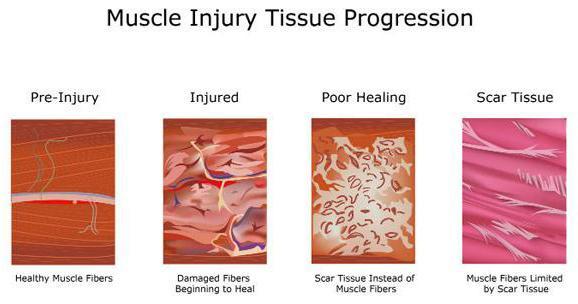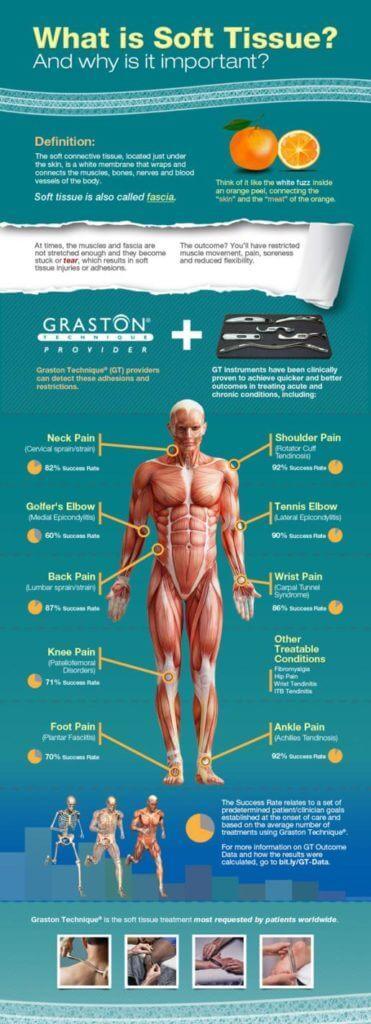Graston Technique
The Graston Technique is an Instrument Assisted Soft Tissue Mobilization (IASTM) used for diagnosing and treating soft tissue dysfunction.
What Is Graston Technique?
The Graston Technique® is a specialized tool-assisted muscle and soft tissue method. It works by breaking down scar tissue and increasing the movement of connective tissues. Using a specialized stainless steel tool a healthcare professional can identify areas of tissue restriction. They then target those areas to improve how they work and the rate of healing. Graston Therapy can stop pain.
This technique finds its roots in a traditional Chinese method that promotes healing by scraping muscle tissue (without breaking the skin) to stimulate blood flow. People have practiced this method, which is also called muscle scraping, for thousands of years. An athlete named David Graston adopted a variation of it.
Upon successfully treating a knee injury using this specialized massage technique David Graston was determined to introduce it to the rest of the sports world. He has always recognized where this technique came from and given credit where credit is due. But without him, the global sports world may never have discovered the benefits of this ancient healing practice.
Professionals have since used the Graston Technique to help thousands of athletes and weekend warriors recover from strained and pulled muscles, ligaments, and tendons. Patients with chronic pain and inflammation have also benefited.
This targeted manual therapy may be a beneficial addition to your treatment plan.
What Is Graston Good For?
When combined with a stretching routine and other therapies, Graston can break up muscle knots and enhance soft tissue elasticity. This can improve the range of motion, and reduce pain or stiffness you feel when moving that joint. It not only speeds up healing but promotes more effective healing—with fewer scar tissues getting in the way of natural movement.
Download our Graston Technique Brochure.

Could You Benefit From Muscle Scraping?
This ancient alternative medicine therapy may aid in relieving chronic pain, increasing mobility, and helping you recover faster after strenuous exercise. After applying oil to the skin, we use the tool to stimulate blood circulation in the affected area. Better circulation also fosters faster cell recovery. Some providers claim that scraping muscles can help the immune system and reduce localized inflammation. Traditionally, natural healers used it to treat a cold, fever, chronic neck pain, tension headaches, and even some lung problems. While these are not common conditions we treat with Graston, you could certainly try it for those conditions as well.
How Does Graston Technique Work?
The Graston Technique combines the use of a stainless steel tool with a specialized massage technique to find soft tissue tightness, adhesions, and scar tissues that the method can improve. A healthcare provider then uses the instrument to massage the area in combination with special stretching movements to relax tight tissues and support natural healing.
Graston Technique is successful because it disrupts the pain cycle and scar tissue formation. During the first Graston session, scar tissue is identified and broken up. But this is only the first step.
Over several sessions, the Graston Technique discourages new scar tissue formation. It encourages the body to instead more thoroughly restore tissues so that they function more closely to the pre-injured state. For this reason, it’s important to keep the Graston Technique plan established with your healthcare provider to experience more than short-term benefits.
Different fibers make up the muscles. As fibers become tight, they build up toxins. The controlled inflammation that Graston generates helps flush out these toxins.
Breaking Up Myofascial Bonds
At the same time, it breaks up collagen cross-links in your structural latticework of fascia tissues that surround and support other tissues. We call the fascia that surrounds muscle tissue “myofascia”.
When underused, overused, or misused myofascial tissues develop “cross-links”. These are a jumble of glue-like bonds that stick together where they shouldn’t and limit movement. Similar malfunctions occur in the tendons, ligaments, and surrounding tissues leading to stiffness and pain. So, breaking these irregular structures up can relieve tension and restore function.
Your healthcare provider uses the instrument in a gliding motion to stretch and relax the muscle tissues, breaking up those collagen cross-links and scar tissues. This can lead to positive changes in soft tissue flexibility and range of motion.
How Is Graston Done?
In the clinic, we begin treatment by warming up your muscles. Then,we apply pressure with the tool gently across the injured area using big, broad strokes. The steel tool helps the provider to feel for muscle vibrations and identify specific areas to work. Most patients can benefit greatly by incorporating this technique with their chiropractic adjustments.

Is Muscle Scraping Safe?
Firstly, scraping muscles is not recommended for every person. If you had any surgery in the last five weeks or have certain medical conditions, you should stay away from Graston therapy. Since the technique promotes the circulation of blood, people who are taking blood thinners or have clotting disorders also must avoid this form of therapy.
Do not try scraping muscles if you have deep vein thrombosis, an infection, a tumor, or a wound that has not fully healed, or you have an implant such as a pacemaker or internal defibrillator.
Does The Graston Technique Work?
What Is Graston Technique Used For?
Can Graston Technique Help Arthritis?
Graston can break up adhesions and scar tissue that restrict the range of motion and lead to joint tissue breakdown and inflammation. When performed by a professional and combined with moderate physical activity and other treatments, Graston can reduce arthritis symptoms and improve how the joint functions.
Is Graston Good For Muscle Strain?
The Graston method is effective for many kinds of soft tissue injuries, strains, strains, and pains caused by repetitive stress trauma, or subluxation (dislocation).

The benefits of scraping muscles outweigh any side effects, especially for athletes who feel tight spots or soreness after training sessions. So, if you live or work near the San Francisco Telegraph Hill – North Beach – Financial District and feel you would be a good candidate for our Graston therapy, we would love to meet you. To schedule an appointment with our San Francisco Chiropractor, please call 415–421–1115 or book an appointment online.
What Is Graston Good for?
- Achilles Tendonitis
- Carpal Tunnel Syndrome
- Cervical Sprain/Strain
- Trigger Finger
- Plantar Fasciitis
- Tension Headaches
- Fibromyalgia
- Lateral Epicondylitis or Tennis Elbow
- Medial Epicondylitis or Golfer’s Elbow
- Lumbar Sprain/Strain
- Rotator Cuff Syndrome
- Shin Splints
- Sports Injuries
FAQ
When we perform Graston we use the stainless steel tool to first identify the injured area. We then work using Graston to break up injured tissues so they can heal more thoroughly. Yes. Most people will experience some minor discomfort. But the Graston technique should not be painful.
The Graston Technique initiates one of the body’s natural immune responses—inflammation. While people often think of inflammation as bad, short-term inflammation is an essential part of healing.
It flushes toxins and damaged cells out of the area while sending in cells that promote faster healing. Redness, swelling, and bruising may occur and last for 24-48 hours. This should not be confused with chronic inflammation.

There are several stainless steel Graston tools used to identify the adhesions and scar tissue before correcting them. Here is a look at the Graston Technique for Plantar Fasciitis.
The frequency depends on the individual and what the Graston is for. Most people will need 1-2 sessions a week with at least 48 hours in between sessions.
Most patients experience some beneficial, short-term results after just one session. However, it typically takes 6-12 sessions of the Graston Technique to realize longer-term benefits.
Active Release (ART) is another soft tissue release technique that can be used with Graston or as a standalone therapy. While they may seem similar, they are very different.
ART focuses on the whole structure instead of a specific section. It identifies structures that are blocking proper blood flow, nerve function, and lymphatic drainage and applies therapy almost always applies pressure in the direction of venous drainage. It also uses the more active motion of the patient instead of primarily using the tools.
As far as similarities, it does help break up scar tissues, adhesions, and myofascial collagen cross-links as Graston does. But it may not be able to do so as well because ART is less targeted and only moves in one direction.
Acupuncture, ART, Graston, and other treatments all have a distinct purpose in your treatment plan.